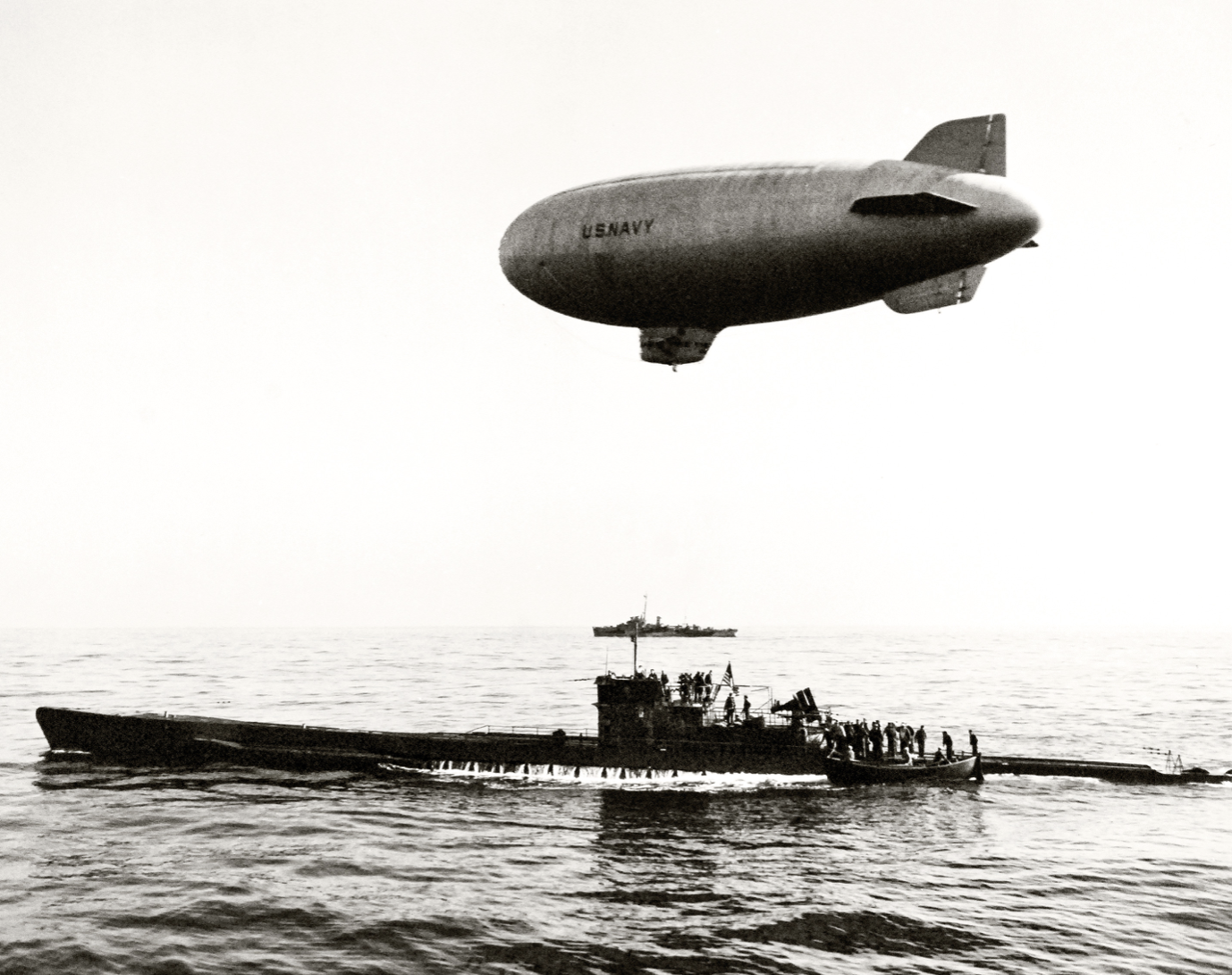
In May 1945, a German submarine surfaced off Cape Henlopen. The officers and crew couldn’t have picked a better place to give themselves up.By Bill Newcott
From the April 2023 issue

Imagine you’re waging war from a submarine, patrolling the enemy’s coast 4,000 miles from home. Suddenly you get a radio flash: “Hey, guys, we’ve just surrendered. The war is over.”
What do you do? Do you turn around and cruise across a stormy ocean to a defeated homeland? Try to find a port in some neutral country?
Or, you might do what German sub captain Thilo Bode did off the East Coast on May 10, 1945: surface, reveal your position via a distress signal — and have your 44-man crew stand in formation on deck, hoping against hope the approaching U.S. warships won’t sink you.
Finally, you just might end up seeing your captured sub towed into the harbor at Lewes — and docked alongside the pier at Cape Henlopen.
The surrender of U-858, a 252-foot-long type IXC/40 sub, unfolded in rolling seas as the destroyers USS Pillsbury and USS Pope took possession. Above them, a pair of U.S. Navy dirigibles circled like turkey vultures sizing up a dying possum.
Victory in Europe Day had been declared two days earlier. As the entire nation breathed a sigh of relief (while casting a nervous eye on the Pacific theater), the last thing Americans were thinking about was a rogue postwar stateside encounter with a Nazi sub.
“After the surrender, U-858 would have been towed right along here,” says Steve Katona, a staffer at the Fort Miles Museum on Cape Henlopen. From our sand dune-top vantage point, near the museum (formerly Fort Miles’ Battery 519), his finger traces a line from right to left, from open sea to the Lewes breakwaters. U-858 ended up tied to a dock located where today visitors drop their lines off the Cape Henlopen fishing pier.
Katona lowers his hand and sighs.
“That must have really been something.”
Early in the war, the Reich had waged a devilishly effective hit-and-run sub campaign from Maine to Cape Hatteras. Operation Drumbeat, as it was called, sank more than 300 ships, mostly merchant vessels, and killed more than 6,000 sailors. Fourteen ships were destroyed off New Jersey alone. It would have had a devastating effect on U.S. morale — if the public had ever found out about it.
“The government did a really, really good job keeping those submarine attacks a secret,” says John Warren, leaning over a conference table deep within the concrete casements at Fort Miles. A historian and member of the Fort Miles Historical Association’s board of directors, Warren oversees the museum’s growing exhibitions, including a section focusing on U-858.
“Basically, they didn’t want to admit that the nation had endured a second Pearl Harbor, but that’s exactly what happened.”
These underground bunkers, which once stored shells and gunpowder for Fort Miles’ big guns, are a legacy of those early attacks.
Fearing the sight of a German flotilla churning upriver, in the early months of World War II, the U.S. poured men, weaponry, and untold tons of concrete into Fort Miles. Besides its enormous guns and network of submerged mines stretching all the way to Cape May, at the height of hostilities some 2,200 soldiers were stationed there to guard the strategic entrance to the Delaware River.
German naval vessels continued to pester the Eastern Seaboard — often hassled from above by members of the fledgling Civil
Air Patrol — but the guns of Fort Miles, intended to deter or attack surface ships, were never asked to train their sights on a single sub.
As the German threat diminished in 1945, the U.S. Army dramatically reduced the fort’s complement of troops, reassigning them to far-flung outposts where they were more urgently needed.
But the U-boats would return. As Allied troops marched toward Berlin in 1945, the Germans sent six subs to launch a last-ditch campaign against America’s East Coast. Even then, Fort Miles never fired one of its guns in anger.
Ironically, the fort’s one and only face-to-face encounter with a German sub came a week after its enemy had been vanquished.
Marching in tight formation, 12 German seamen follow two officers in solemn procession along the concrete road that bisects Fort Miles, their footsteps echoing off the block buildings that line the street. Behind them walk a pair of U.S. soldiers, bearing machine guns, with black “MP” bands on their left sleeves.
On order, the small brigade of sailors comes to a smart halt. The German officers continue forward, coming within a pace of a commanding U.S. Army officer, standing at attention in the middle of the road.
“Do you have any weapons?” The U.S. officer asks. The German officers shake their heads.
“Well, we have to follow procedures here,” the U.S. officer continues. “I’m going to ask for your assistance in asking your men to cooperate as our soldiers check them for weapons.”
Nervous laughter floats through the gathered onlookers — a congregation of 21st century history buffs on hand to witness Fort Miles’ annual reenactment of the U-858 surrender. The “sailors” and “soldiers” here are actually members of the Harbor Defenses of the Delaware Living History Association — volunteers who spend some of their spare time reenacting World War II-era events like this.
After a few more formalities, the glum-looking, newly minted POWs — some portrayed by local high school kids — climb aboard a flatbed military truck and are trundled off.
Unlike most reenacted military operations, you can also witness the real thing in a remarkably preserved film available on YouTube — starting with U-858’s at-sea surrender and continuing all the way through to the humbling pat-down (unlike the reenactment, the body search really took place on the dock, as soon as the crew was brought ashore).The film lasts about 12 minutes, and throughout, it’s hard to take your eyes from the faces of the captured German sailors. At first poker-faced and stoic, the young men slowly betray a dazed, growing realization that nothing bad is going to happen to them. Add to that the fact that, in its relatively short war career, U-858 never so much as fired a torpedo in battle nor was ever attacked by Allied forces, and it can be argued that we are looking at the luckiest submariners in the German navy — and they know it.
U-858 remained moored at the dock for several months — toured by residents and schoolchildren — before it was towed to Philadelphia to be stripped.
Mounted in one of Fort Miles’ cavernous gun rooms is an original twin-barreled German Flak 38 anti-aircraft gun, the kind used on the deck of Germany’s submarines. In 2004 it was found in, of all places, a wooded area behind Delaware Technical Community College in Georgetown.
At first there was a glimmer of hope that the gun was from U-858 , but it turned out to be off her sister sub, U-853, which was sunk in battle near the entrance of Long Island Sound three days before the war’s end. The gun had been salvaged in 1968 by Millsboro businessman Melvin Joseph — a well-heeled sponsor of scuba expeditions. As a member of the college’s board of directors, Joseph apparently brought the gun to campus in the 1970s, planning to put it on display there. Perhaps due to general antiwar sentiment at the time, that never happened.
After its discovery, Fort Miles volunteers poured eight years of effort into restoring the gun. Today it looms over a scale model of the captured U-858 arriving at Cape Henlopen, the Stars and Stripes fluttering from her conning tower.
The U-858 POWs were technically interned by the Army, but many found themselves engaged in what amounted to work-release programs.
One POW was assigned to assist the camp telephone operator, Lydia Wagamon. Thumbing through a copy of Life magazine, he noticed — in a photo spread about President Harry S. Truman’s presidential yacht, Sequoia — a painting of two War of 1812-era schooners.
“For some reason, that painting grabbed the POW’s attention,” says historian Warren. “He wanted to do something nice for Lydia, so he painted a copy for her. And here it is.”
Warren walks me to a remarkably accomplished oil painting, intricate in its detail of the ships’ rigging, powerful in its sense of wind filling the enormous, billowing sails. Nearby is a copy of that Life issue, open to the page with the painting, shown hanging above a fireplace. The black-and-white image of the original artwork is not much larger than a postage stamp.
“He not only copied it from that tiny image,” says Warren, “but he also colorized it. And he did the whole thing in two weeks.”
The happiest ending to this story would be with the decommissioned U-858 winding up in a museum; maybe even permanently berthed at the Cape Henlopen dock. But the postwar U.S. Navy wasn’t all that sentimental when it came to the enemy submarines that wreaked havoc in the North Atlantic: Along with a cluster of sister German subs, U-858 was sunk in a naval exercise 300 miles off Cape Cod. Today it lies scuttled under thousands of feet of water.
I’m standing with Steve Katona on The Overlook, the concrete event space that spreads beyond Battery 519. In the mid-afternoon sun, Cape May cuts a low profile across blue Delaware Bay.
“There’s a lot of ship traffic out there today,” he observes. “Heading up to Philadelphia, probably.”
I can’t help but wonder what the war-weary young men who peered across this expanse 80 years ago, on 24-hour lookout for enemy vessels, would think of the fact that every year a half-dozen or so young couples choose this venue as a romantic spot to exchange their “I do’s.”
Katona shakes his head.
“Man,” he says, “it was a different time.”



